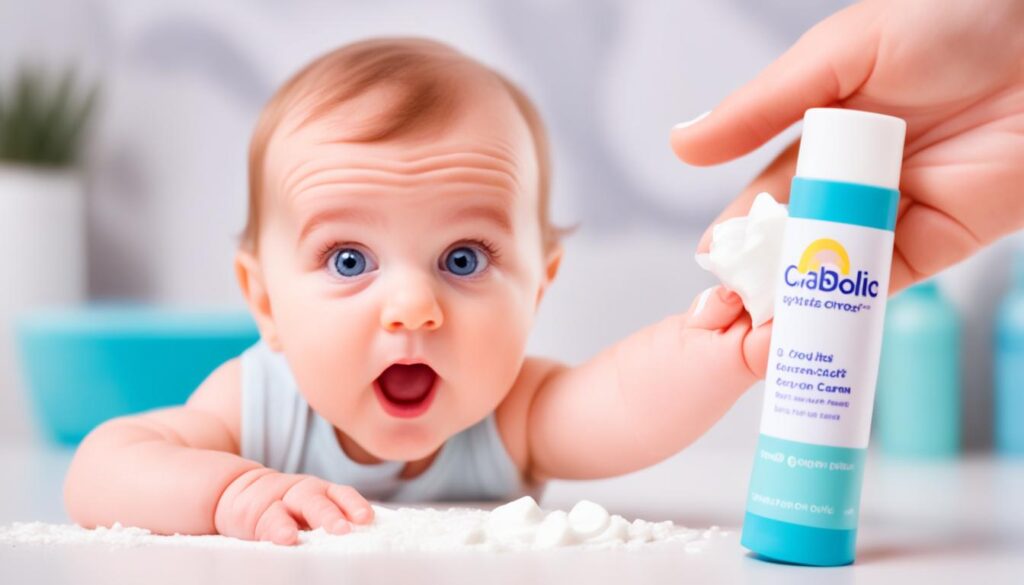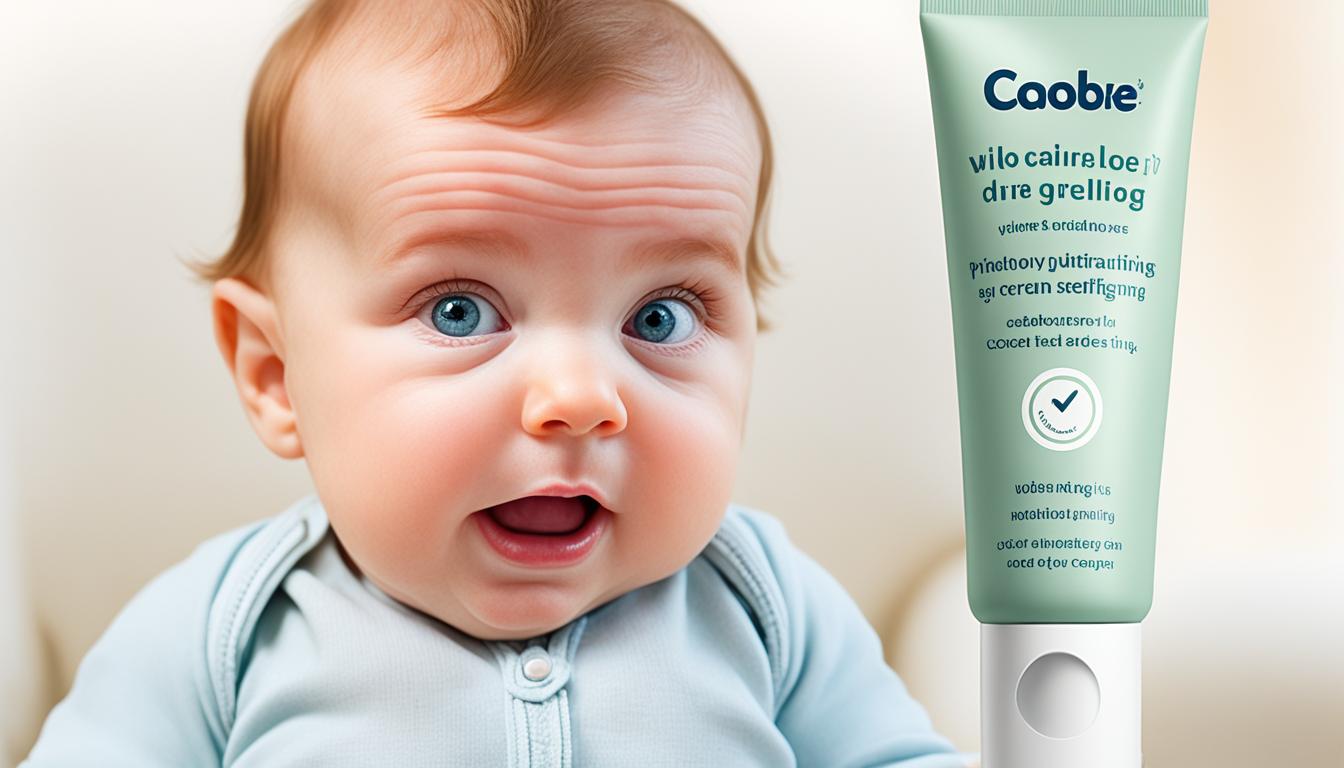As a parent, the health and well-being of your baby are of utmost importance. When it comes to skincare, zinc oxide is a commonly used ingredient in products for babies, such as creams and ointments. But is too much zinc oxide bad for your little one? It’s essential to understand the potential risks and ensure the safety of your infant.
Zinc oxide is generally safe for babies when used correctly. It has soothing and healing properties, making it an effective ingredient for treating minor burns and skin irritations. However, excessive exposure to zinc oxide can lead to toxicity, posing potential health risks for your baby.
Key Takeaways:
- While zinc oxide is generally safe for babies, excessive exposure can lead to toxicity and potential health risks.
- Zinc oxide is commonly found in baby skincare products like creams, ointments, and diaper creams.
- Symptoms of zinc oxide overdose may include fever, cough, diarrhea, throat irritation, nausea, and vomiting.
- To prevent zinc oxide poisoning, use products containing zinc oxide according to the recommended guidelines and consult with healthcare professionals if needed.
- In case of zinc oxide exposure or suspected poisoning, seek immediate medical attention and contact your local poison control center or the Poison Help hotline.
Understanding Zinc Oxide Overdose
Zinc oxide overdose can have serious consequences for infants if they accidentally ingest or inhale products containing this ingredient, such as creams, diaper creams, or ointments. It’s essential for parents and caregivers to be aware of the symptoms and take immediate action to prevent further harm.
Common signs of zinc oxide overdose in infants include fever, cough, diarrhea, mouth and throat irritation, nausea, and vomiting. These symptoms can vary in severity depending on the amount of zinc oxide exposure and the individual baby’s sensitivity.
If you suspect that your baby has ingested or been exposed to an excessive amount of zinc oxide, do not hesitate to seek immediate medical attention. The health and well-being of your little one are of the utmost importance.
“Prompt medical intervention plays a critical role in cases of zinc oxide overdose to prevent potential complications. Never hesitate to contact your healthcare provider or local poison control center for guidance.”
Sources of Zinc Oxide
Zinc oxide is a common ingredient found in a variety of baby products, including baby sunscreen and diaper creams. These products are specifically formulated to provide protection and relief for babies’ delicate skin. The use of zinc oxide in these products helps to create a physical barrier that safeguards the skin from harmful sun rays and prevents diaper rash.
When it comes to protecting babies from the sun, baby sunscreens containing zinc oxide are an excellent choice. The mineral-based formula ensures broad-spectrum protection against both UVA and UVB rays, reducing the risk of sunburn and long-term damage. Remember to apply sunscreen generously and frequently, especially during periods of prolonged sun exposure.
“Using baby sunscreen with zinc oxide is a highly effective way to protect your little one’s skin from the sun’s harmful rays. It provides a physical barrier that reflects and scatters the UV radiation away from the skin, offering superior protection compared to chemical sunscreens.” – Dr. Emily Peterson, Pediatric Dermatologist
In addition to sunscreen, zinc oxide can also be found in diaper creams for infants. These creams help to soothe and protect the delicate diaper area, preventing and healing diaper rash. The gentle and hypoallergenic nature of zinc oxide makes it suitable for even the most sensitive skin. Remember to apply diaper cream during every diaper change to keep your baby comfortable and rash-free.
It’s important to note that while zinc oxide is generally safe when used as directed, excessive and prolonged use can increase the risk of toxicity. Therefore, it’s crucial to follow the recommended guidelines and avoid overusing products containing zinc oxide to ensure the overall well-being of your baby.
Symptoms of Zinc Oxide Poisoning
Zinc oxide poisoning can have various symptoms in babies that should not be overlooked. These symptoms may indicate an overdose of zinc oxide, and immediate medical attention is crucial to ensure the well-being of your little one.
- Fever: Elevated body temperature is a common sign of zinc oxide poisoning in infants.
- Chills: Unexplained shivering or feeling cold even in warm environments.
- Cough: Persistent coughing without any apparent cause.
- Diarrhea: Frequent loose or watery stools.
- Mouth and throat irritation: Discomfort, redness, or swelling in the mouth and throat area.
- Nausea: Feeling queasy or experiencing the urge to vomit.
- Vomiting: Forceful ejection of stomach contents.
- Stomach pain: Abdominal discomfort or cramping.
- Yellowing of the eyes and skin: Also known as jaundice, a condition characterized by a yellowish tint in the whites of the eyes and the skin.
It’s important not to ignore these symptoms, as they may indicate an overdose of zinc oxide. Seek immediate medical attention if you notice any of these signs in your baby.
Remember, your vigilance and prompt action can make a difference in your baby’s health and well-being.
Zinc Oxide Poisoning Prevention
When it comes to using zinc oxide on babies, prevention is key in ensuring their safety and well-being. By following the recommended guidelines and taking necessary precautions, you can significantly reduce the risk of zinc oxide poisoning.
Use Products According to Guidelines
It is essential to use products containing zinc oxide in accordance with the recommended guidelines. This includes using the appropriate amount and frequency of application as stated on the product packaging. By following these instructions, you can ensure that your baby receives the intended benefits of the product without exceeding safe levels of exposure.
Avoid Excessive and Prolonged Use
While zinc oxide is generally safe for babies, excessive and prolonged use can increase the risk of toxicity. It is important to apply the product sparingly and only as needed, especially in areas with broken or irritated skin. Avoid using high concentrations of zinc oxide on a regular basis to minimize the potential for adverse effects.
Consult with Healthcare Professionals
If you have any concerns or questions about using zinc oxide on your baby, it is always advisable to consult with a healthcare professional. They can provide personalized guidance based on your baby’s individual needs and help alleviate any worries you may have. A healthcare professional can also recommend suitable alternatives or adjustments to your baby’s skincare routine if necessary.
Remember, the health and safety of your baby are of utmost importance. By using products containing zinc oxide responsibly and seeking professional advice when needed, you can ensure that your baby’s skin remains protected and healthy.
What to Do in Case of Zinc Oxide Exposure
In case of zinc oxide exposure or suspected poisoning, immediate medical attention is crucial for the safety of your baby. If you believe your baby has been exposed to an excessive amount of zinc oxide, it’s important to take prompt action. Here are the steps you should follow:
- Contact your local poison control center or call the national Poison Help hotline at 1-800-222-1222 for further instructions. These professionals are specially trained to provide guidance in case of poisoning emergencies.
- Be prepared to provide relevant information about your baby, including their age, weight, the product involved, the time of exposure, and the amount ingested or in contact with the skin. This information will assist the medical professionals in assessing the situation and providing appropriate guidance.
- Follow the instructions given by the poison control center or hotline operator diligently. They may ask you to observe and monitor your baby for specific symptoms or advise you on the immediate steps to take to mitigate the effects of zinc oxide exposure.
“Immediate medical attention is crucial in case of zinc oxide exposure or suspected poisoning. Contact your local poison control center or call the national Poison Help hotline at 1-800-222-1222 for further instructions.”
Remember, the prompt action is essential in situations like these. Seeking professional guidance and providing accurate information will aid in ensuring the well-being of your baby.
Treatment for Zinc Oxide Poisoning
When it comes to treating zinc oxide poisoning, the approach will depend on the severity of the symptoms. If your baby has ingested or been exposed to an excessive amount of zinc oxide, it’s important to seek medical attention immediately. Remember, I am not a healthcare professional, but I can provide some general information on the treatment options for zinc oxide poisoning.
In some cases, medical professionals may administer activated charcoal, a substance that can help absorb the zinc oxide and promote its elimination from the body. This can be done by giving your baby a carefully measured dose of activated charcoal, under the guidance of a healthcare professional.
If your baby is experiencing respiratory distress or compromised breathing due to zinc oxide exposure, breathing support measures may be necessary. This can involve providing oxygen therapy or using a ventilator to assist with breathing.
In severe cases, intravenous fluids may be administered to help maintain hydration and support organ function. These fluids can help flush out the zinc oxide and promote its excretion from the body.
In some situations, healthcare professionals may use laxatives to aid in the removal of zinc oxide from the body. Laxatives can help stimulate bowel movements and facilitate the elimination of the zinc oxide through the digestive system.
If the zinc oxide product has come into contact with your baby’s skin or eyes, immediate skin and eye washing is essential. Rinse the affected areas with plenty of clean water for at least 15 minutes to remove any remaining zinc oxide particles.
Remember, this information is for informational purposes only and should not replace medical advice from a qualified healthcare professional.

Long-Term Effects of Zinc Oxide Poisoning
In most cases, recovery from zinc oxide poisoning is likely with proper treatment and avoiding further exposure. However, it is important to be aware that long-term exposure to zinc oxide fumes in industrial settings can lead to serious lung disease.
If your baby has experienced zinc oxide poisoning, it is essential to monitor their health closely. Look out for any lingering symptoms or concerns that may arise even after initial treatment. If you notice anything unusual or have any concerns, it is important to seek medical attention for a thorough evaluation.
Remember, the well-being and safety of your baby should always be the top priority.
“Long-term exposure to zinc oxide fumes in industrial settings can lead to serious lung disease.”
Importance of Zinc Oxide Safety
While zinc oxide has various benefits for babies, including its skin protection and healing properties, it is crucial to prioritize safety when using this ingredient. Excessive exposure to zinc oxide can have harmful effects and potentially lead to toxicity in infants. To ensure the well-being of your baby, it is important to follow proper guidelines and consult with healthcare professionals.
Zinc oxide can be found in many baby products, such as sunscreen and diaper creams. These products are designed to provide relief and protection for delicate baby skin. However, it is essential to use them responsibly and in moderation to avoid any potential risks.
To ensure zinc oxide safety for infants, it is advisable to:
- Use products containing zinc oxide according to the recommended guidelines provided by the manufacturer.
- Avoid excessive and prolonged use of products with high concentrations of zinc oxide.
- Consult with a healthcare professional if you have any concerns or questions about using zinc oxide on your baby’s skin.
Taking these precautions can help minimize the risk of zinc oxide toxicity in infants and ensure the safety of your little one.
“The safety of our babies is of utmost importance, and using zinc oxide responsibly is a crucial part of that. By following the recommended guidelines and seeking professional advice when needed, we can ensure our little ones are protected and safe.”
Understanding Zinc Oxide in Baby Products
When it comes to caring for your baby’s delicate skin, many products on the market utilize zinc oxide as an active ingredient. This versatile compound is found in a range of baby items, including diaper creams and sunscreens, and is specifically formulated to provide protection and soothing relief.
However, as a parent, it’s essential to be aware of the concentration of zinc oxide in these products and how to use them correctly. Understanding the importance of proper application and adherence to recommended guidelines can ensure the safety and effectiveness of these baby products.
When using diaper creams containing zinc oxide, apply a thin layer to clean, dry skin. Gently spread the cream across the affected area, ensuring even coverage. Avoid over-application, especially in areas with broken or irritated skin.
Similarly, when using zinc oxide-based sunscreens on your baby, follow the instructions provided by the manufacturer carefully. Apply a liberal amount to exposed skin, paying extra attention to areas prone to sunburn, such as the face, shoulders, and back of the neck. Reapply sunscreen every two hours or as directed by the product labeling.
Remember, zinc oxide products can vary in concentration, so it’s crucial to read the labels and choose the appropriate formulation for your baby’s age and needs.
In addition to proper application, it’s vital to keep an eye out for any adverse reactions or unusual symptoms. If you notice redness, irritation, or if your baby appears uncomfortable after using a product containing zinc oxide, discontinue use and seek medical advice.
Why Zinc Oxide?
Zinc oxide is valued for its ability to form a protective barrier on the skin, shielding it from harmful UV rays and irritants. Its anti-inflammatory properties can also help soothe and heal minor skin irritation, making it a popular choice for baby care products.
To ensure the well-being of your baby, it’s essential to be knowledgeable about the ingredients used in the products you use. By understanding zinc oxide and its applications in baby products, you can make informed decisions and keep your little one’s skin healthy and protected.
Safety Measures for Using Zinc Oxide on Babies
When it comes to using products containing zinc oxide on babies, following the instructions provided by the manufacturer is crucial. Proper application and adherence to safety precautions can help ensure the well-being and comfort of your little one.
Here are some essential safety measures to keep in mind:
- Apply a thin layer of the product: It’s important not to over-apply zinc oxide cream or any other product containing zinc oxide on your baby’s skin. Using a thin layer will provide adequate protection without causing excessive build-up.
- Avoid over-application on broken skin: If your baby has any cuts, scrapes, or open wounds, it’s best to consult a healthcare professional before using products with zinc oxide. They can guide you on proper usage and recommend alternative options if necessary.
- Monitor for adverse reactions: Every baby’s skin is unique, and some may be more sensitive to certain ingredients. Keep a close eye on your baby’s skin after applying zinc oxide products, and if you notice any redness, irritation, or unusual symptoms, discontinue use immediately and consult a healthcare professional.
Remember, the well-being of your baby is of utmost importance. If you have any doubts or concerns about using zinc oxide on your little one, it’s always a good idea to consult with a healthcare professional. They can provide personalized guidance based on your baby’s specific needs.
“Proper application and adherence to safety precautions can help ensure the well-being and comfort of your little one.”
Before using any new product on your baby’s skin, perform a patch test by applying a small amount on a small area of their skin and observing for any adverse reactions. This can help you determine if your baby has any sensitivities to the product before applying it more broadly.
By following these safety measures and being mindful of your baby’s individual needs, you can confidently use zinc oxide products to protect and care for their delicate skin.
Conclusion
In conclusion, it is important to exercise caution when using zinc oxide products on babies. While zinc oxide is generally safe for infants, excessive exposure can have harmful effects on their health. By following the recommended guidelines for product usage and seeking medical attention if any concerns or symptoms arise, you can ensure the well-being and safety of your baby.
Remember, the key is to use zinc oxide products in moderation and only as directed. Applying a thin layer of the product and avoiding over-application, especially on broken skin, is crucial. If you notice any adverse reactions or unusual symptoms, discontinue use and consult with a healthcare professional.
Your baby’s safety and health should always be the top priority. So, be mindful of the potential risks associated with excessive zinc oxide exposure and take the necessary precautions to keep your little one safe. By using zinc oxide products responsibly, you can protect and care for your baby’s delicate skin without compromising their well-being.


